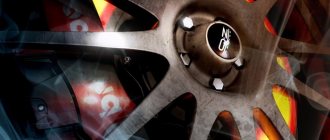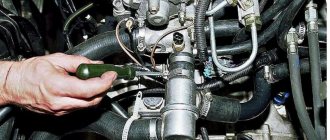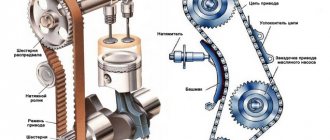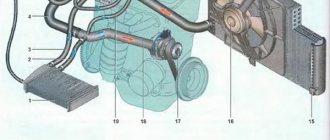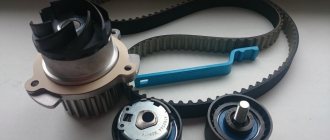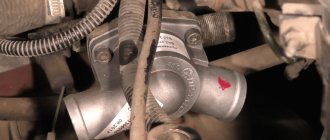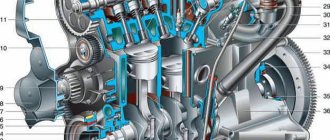Signs, causes and consequences of car engine overheating
One of the most dangerous and common problems that entails serious consequences in the form of a major overhaul of the internal combustion engine or its replacement is engine overheating. This problem mainly occurs in the summer, but some faults can cause this problem in cooler periods. It is easier to avoid overheating of the car's heart than to later eliminate the serious consequences of even a single excess of operating temperature. To do this, you need to know the symptoms and ways to quickly eliminate such a problem.
Reasons why the engine may overheat
The cooling system, which can be filled with antifreeze, antifreeze or plain water, protects the internal combustion engine from overheating.
The main devices that monitor operating temperature and reduce it are:
A malfunction in any of the above components can lead to overheating. In addition to malfunctions of the above devices, overheating can be caused by both external factors and other internal faults.
External overheating
If symptoms of overheating appear, it is necessary to carry out an external inspection of the radiator, motor and cooling system.
The main causes of external overheating:
Internal overheating
There are many reasons for internal overheating, and not all of them can be detected visually, and some will have to be looked for by a qualified car mechanic.
Causes of internal combustion engine overheating:
Consequences of mild, moderate and severe overheating
The consequences and cost of repairs depend on the degree of overheating of the internal combustion engine. Timely maintenance of the car, monitoring the coolant level and temperature conditions when driving reduces the occurrence of overheating significantly.
Slight overheating of the internal combustion engine occurs when the engine operates at a temperature exceeding the temperature for 4-12 minutes. This mainly occurs when the thermostat or fan malfunctions, and the driver detects this in a timely manner and takes action.
In many cases, such a situation, if it occurs once, does not affect the condition of the engine, especially if it has a short mileage. The pistons often melt slightly; when the temperature rises significantly, even for a short time, dark-colored smoke appears from the muffler, and there is a feeling that the engine is constantly running under load.
Even after a single short-term overheating of the engine, it will subsequently begin to heat up more often due to changes in the pistons and the remaining melted metal in the cylinders.
The average degree of overheating of the internal combustion engine appears when the engine is running at extreme temperatures for at least 20 minutes. There are many reasons for this situation and they have all been described earlier.
The consequences of such overheating are already more tragic. In addition to the consequences characteristic of mild overheating, which manifest themselves to a greater extent, there are added skew of the cylinder head or the appearance of cracks in it, burnout of cylinder head gaskets, ejection of the valve seat, severe deformation of the pistons, destruction of the inter-ring partitions of the pistons, oil leakage from under all kinds of gaskets and seals .
Severe overheating of the internal combustion engine causes all sorts of very serious consequences. In this case, individual working units may survive or the engine can be thrown out.
The main consequences of excessive engine overheating:
What to do if the engine has already started to overheat
If overheating has begun or is suspected, it is necessary to take immediate action to avoid serious problems with the engine in the future.
If the needle has just entered the red zone (overheating zone), then you can turn off the engine, but it is advisable to cool it a little by turning it on to the maximum temperature and blowing on the stove.
In any case, it is necessary to inspect the radiator and engine compartment. If there is liquid in the expansion tank, then you can cool the engine a little by turning on the heater fan to the maximum temperature and blowing mode.
If there is a complete absence of coolant in the tank, turning on the heater at maximum mode will not help cool the internal combustion engine, and may worsen the situation. In this case, it is necessary to turn off the engine and transport the car to the repair site using a tow truck.
If minor leaks are detected in the cooling system after the engine has cooled, it is possible to add water or coolants. Under no circumstances should you add any liquid to the expansion tank of a hot engine, since the difference in temperatures can lead to cracks in different components of the internal combustion engine or other consequences.
It is strictly forbidden to water the engine, since in this case its repair is inevitable due to the appearance of cracks in the cylinder block body.
An overheated engine is turned off only in certain cases: when steam appears from under the hood, indicating a significant leak in the cooling system, or a complete absence of coolant in the tank.
Even a slight overheating of the motor, at best, will lead to unpleasant consequences in the future, and significant overheating can almost completely destroy its insides, which will lead to the need to install another motor.
Such situations can be prevented; to do this, it is necessary to constantly monitor the coolant level, do not pour water into the cooling system, change the cooling pump and working fluids in a timely manner, regularly inspect the pipes for the appearance of cracks in them, and monitor the cleanliness of the radiator and engine housing.
Source
Design of the Priora internal combustion engine cooling system
Below in the picture you can see a diagram of the engine cooling on a Priora with a description of its components.
The cooling system includes the following elements:
- Cooling radiator;
- Water pump (pump);
- Thermostat;
- Interior heater;
- Expansion tank and its cover;
- Cooling Fan;
- ICE shirt;
- Pipes;
All these details seriously affect the operation of the SOD, namely its effectiveness. Failure or improper operation of one of the parts can lead to malfunctions in the operation of the internal combustion engine and its overheating.
Priora heats up at speed
Lada Priora cannot be called a miracle of engineering in terms of technical equipment. For the most part, this model inherited the components and assemblies of its predecessors. The cooling system was no exception. On the Lada Priora it is combined: liquid with partial natural and forced air cooling. In this case, the type of engine does not matter: for the 8-valve and 16-valve power units it is almost identical.
Device and features
The cooling system of the Priora internal combustion engine has a standard set of main components:
By circulating through the large and small circuits, the coolant prevents the engine from overheating, maintaining the desired temperature. Structurally, the cooling system of the Priora is simple and no different from other internal combustion engines with an injector, with the exception of small parts.
Radiator and forced cooling fan
They mainly serve to bring the working fluid to the optimal temperature for the functioning of the engine (the operating temperature of the Priora engine with 16 valves is 90–95 degrees). The predecessor of the Priora VAZ 2110 often installed a cooler made of copper alloys, but due to cheaper prices, designers switched to aluminum analogues.
The operation of the fan depends on the engine control unit.
It receives information from the DTOZH (this is a sensor that reads temperature readings) located in the water jacket of the power unit. If the permissible temperature values are exceeded, the control unit connects an electric fan to improve cooling efficiency. A faulty fan or clogged radiator can lead to a constant increase in optimal engine temperatures, which shortens the service life and can cause costly repairs.
Thermostat
Its task is to promptly open coolant access to a large circle of the engine cooling system (engine cooling system) after the engine reaches the optimal temperature. In simple terms, the thermostat allows you to quickly warm up the engine and regulates the operation of the entire system. During warming up, the thermostat valve is in the closed position, antifreeze does not flow through the large circuit (the radiator is not activated). As it warms up, the valve opens slightly under the influence of rising temperature, and antifreeze begins to move through the radiator along a larger circuit.
A thermostat malfunction can result in overheating of the power unit (if the valve is stuck closed) or, conversely, the operating temperature rises very slowly (when the valve is stuck in the open position). Overheating is much more dangerous. Beginners can identify this malfunction if the engine heats up all the time and the fan on the Priora is constantly running.
Pump (water pump) and heater
Without the first part, the coolant circulation circuit in the system is impossible. If the water pump is faulty, at best there will be a coolant leak from the system. In the worst case, the pump may jam, which will lead to a broken timing belt and subsequent problems, the solution of which will result in expensive repairs.
The heater, or simply the stove, consists of a radiator, pipes and a fan. Can additionally cool the antifreeze in the system. An indispensable unit in winter. Provides the interior with warm air.
Connecting elements and expansion tank
It serves as a receiving compartment where gases and vapors are discharged when the coolant is heated. Also, the expansion tank is the level for the entire cooling system. One of the main elements in the tank is the valve cover through which air is forced out. There is antifreeze, it begins to boil when the engine temperature rises critically.
The connecting hoses serve as a pipeline for the circulation of coolant and connecting elements of all structural units, thus creating a single looped and sealed circuit.
The design of the cooling system also includes an engine temperature sensor on the Priora and an engine jacket. The sensor constantly reads information about the current antifreeze temperature and transmits it to the ECU. The location of the power plant jacket is structurally assumed in the cylinder block housing; it serves to remove heat through the coolant.
Features of cooling system malfunctions
The efficiency of the structure primarily depends on the level of antifreeze in the system and its condition (this liquid has a certain resource, usually up to three years or up to 50,000 km). The main sources of system malfunctions are the thermostat, radiator and electric fan, as well as the water pump, the principle of operation of which is described above.
The radiator most often becomes the source of antifreeze leakage. Accordingly, the liquid level in the system drops, and there is not enough of it for effective heat removal. The motor begins to overheat. It can also be clogged with garbage. And if water is used instead of antifreeze the old fashioned way, scale may form.
The consequences of a faulty water pump are much more serious. In addition to antifreeze leakage, the circulation of coolant in the system may stop and, as a result, the engine will quickly overheat. The worst case scenario is bent valves due to a broken timing belt.
The next common malfunction is burnout of the cylinder head gasket or deformation of the cylinder head of the internal combustion engine system. This leads to coolant entering the fuel combustion chambers. The same thing can happen if cracks appear on the cylinder block.
Coolant leakage is most often associated with loss of tightness of the connecting pipes, because over time, the material from which they are made hardens and wears out, as a result of which it cannot work properly.
On a Priora, a lot depends on the computer, and a faulty coolant temperature sensor can give incorrect readings. For example, if the ECU receives underestimated performance, the engine will begin to overheat. Otherwise, the fan will be constantly on. On the other hand, often the cooling system sensor does not transmit any readings at all. Then the ECU switches the operation to emergency mode.
Reasons why Priora overheats
There can be many reasons for overheating, but they are all of the same type and finding the cause of this illness is quite simple.
Cooling radiator
This part serves to cool the liquid, which, passing through the radiator, is cooled by a counter flow of air and then enters the engine, cooling it. When a radiator becomes dirty or damaged due to an impact, its tubes become bent, preventing the free flow of fluid through the system, thereby preventing the fluid from cooling to the required temperature. Due to this problem, overheating of the internal combustion engine is possible.
The problem can be solved by replacing the radiator with a new one, or by flushing it.
water pump
The water pump is used to help circulate coolant through the system. The pump is a part with a gear, shaft, housing, impeller and bearings. Quite often on a Priora it happens that the impeller on the pump breaks or turns, and this leads to the impossibility of antifreeze circulating through the system and, consequently, to overheating of the internal combustion engine.
The problem is solved by replacing the pump with a new one.
Thermostat
To limit engine cooling and maintain its optimal temperature, a special thermostat valve is used. It stops the circulation of fluid through the radiator, thereby heating the engine to operating temperature; as soon as the optimal temperature is reached, the thermostat opens and allows fluid to flow through the cooling radiator.
It happens that the thermostat gets stuck in the closed position and this leads to overheating of the motor. It is quite simple to determine this malfunction; you just need to touch the lower radiator pipe; it should be hot; if it is colder than all the others, it means that the thermostat is jammed and must be replaced.
Cooling Fan
To cool the engine of a car sitting in a traffic jam, a special fan is used, which simulates the flow of air encountered and cools the radiator. If this part fails, then there will be no cooling of the engine in the plug, which will lead to overheating of the engine.
If the engine cooling fan does not turn on, you need to check the temperature sensor, fuse and power connector.
Engine pipes
After any repairs, some pipes may sometimes become bent, which will lead to the cessation of fluid circulation through the system and overheating of the internal combustion engine. If the Priora is heating up, then it is necessary to check the pipes for integrity and compression.
The VAZ 21124 engine gets hot in traffic jams, reasons, signs of an overheated engine, what to do
Overheating of a car engine is a problem that every driver can face.
In this article we can find out:
To understand the essence of the issue, it is necessary to consistently read all the explanations of an experienced auto mechanic.
How to determine if the engine is overheated
At first glance it seems very simple - according to the indicators of the engine temperature device, or - sensor. This is true, if not for one thing - novice motorists are so captivated by the road situation around them that they look at the instrument panel only in one case - how much fuel is left.
Experienced motorists, on the contrary, due to their confidence in their abilities, also do not look at the car’s dashboard. And as a result, a situation often arises that overheating is detected when the engine temperature has long exceeded permissible limits, and irreparable damage has been caused to the engine.
It is irreparable overheating that is one of the most complex malfunctions, which leads to very serious consequences. But more on that later.
But there is a way that will not let you miss the moment of overheating. This is problematic in a traffic jam, and is not always clearly present, but here’s what you should be aware of:
As soon as the engine temperature exceeds the permissible norm, when you sharply press the gas pedal, or when accelerating the car, even slightly, detonation knocks are clearly heard, which are popularly called “tapping fingers.” This is not true, but everyone knows this definition. If you hear such a sound, there is a 99% chance that the engine has overheated, and action must be taken.
Detonation knock is a loud metallic knock, the frequency of which coincides with the engine speed. You've probably heard such sounds when refueling with low-quality fuel. I personally don’t know where the concept of “tapping fingers” came from. But the real reason for such knocking noises is a disruption in the fuel combustion process.
When the engine overheats, this is the first sign.
What is the permissible engine temperature
Before continuing the conversation, let's define what is normal temperature and what is overheating. There is no one-word answer, but there are general rules. The engine temperature is within 85-95 degrees Celsius, which is working. Engine temperature up to 100 degrees is acceptable. This means that a short-term increase in temperature to 100, sometimes up to 105 degrees is allowed. Just for a short time - up to 5 minutes. Engine temperature above 105 degrees Celsius means overheating and action must be taken.
Reasons that can cause overheating
During long-term use of the car, the piston rings, which serve to seal the combustion chamber, wear out, which leads to a decrease in compression, impaired fuel combustion, loss of power (remember the formula) and overheating of the car. Somehow it turned out to be too difficult. To put it simply: fuel burns better at a certain pressure that is created in the combustion chamber. Pressure is about 12 atmospheres. If you take a pipe, plug it with potatoes and blow inside, pressure will be created inside, which is called compression.
The force with which you blow will represent the force of expansion of the fuel during combustion, which pushes on the piston and causes the crankshaft to rotate. The rings serve to fit the piston more tightly to the cylinder (in our case, potatoes and tube). Now, if you put in a loose piece of potato and blow, the air will pass past the potato piston. This is what happens in the engine when the piston group wears out (ring wear and cylinder wall wear).
By and large, two troubles can happen to the pump: it will simply leak - you will see, and the second, which is more difficult to determine, is wear of the pump impeller. When the impeller wears out, the pump slowly pumps liquid, as a result, the liquid in the engine heats up faster than in the radiator (water circulation worsens). You can tell by uneven heating - the radiator is cold, but the engine is boiling. Attention - the same symptoms occur if the thermostat is malfunctioning or if there is an air lock.
There may also be other reasons - one of which is from the category “you can’t invent it on purpose.” For example, the parking brake is not fully weakened, which leads to the car slowing down, increasing the load on the engine, and overheating. The handbrake cable may get stuck - there was such a case. The car slows down slightly, but this is enough in the heat.
And some people also blame the air conditioner on. By and large, this is rather a far-fetched reason. Of course, the air conditioner creates additional load on the engine, but this was taken into account during the development. If the engine is really bad - complete wear and tear - then this can happen. What to do - turn off the miracle of modern automobile manufacturing.
Perhaps we'll stop there. The only thing we'll talk about at the end is overheating in a traffic jam. No one is immune from this.
What to do if your car overheats in a traffic jam
When driving a car for a long time in a lower gear, the engine operates with increased power, which in itself leads to overheating. Add to this the lack of counter-flow of air necessary to cool the radiator. What to do? The main thing is not to panic. Short-term overheating is not terrible, but if you see that the car is not cooling down, it’s time to act.
This is what it looks like, engine overheating, if you look closely. Now you know why the engine gets hot and how to deal with it.
Didn't find the information you are looking for? on our forum.
, please select a piece of text and press Ctrl+Enter.
The VAZ 21124 engine gets hot in traffic jams, reasons, signs of an overheated engine, what to do Link to the main publication
Why is the radiator cold and the engine hot?
The problem of engine overheating is well known to the vast majority of drivers. In this case, overheating of the engine can lead to serious damage or complete failure of the internal combustion engine. To prevent this from happening, the engine cooling system requires periodic maintenance and constant monitoring of performance.
However, a number of malfunctions may still arise unexpectedly. This means that it is very important to know why the engine gets hot in certain cases. In this article we will talk about common causes of overheating, what to do if the engine is boiling, but the radiator is cold, etc.
Engine overheating: main signs and causes
Let's start with the signs. First of all, this is the engine temperature indicator on the dashboard in the red zone. Also, on some models, a warning light may simply light up, indicating overheating.
Another sign of engine overheating is a decrease in engine power, loss of traction and detonation knocks when you sharply press the gas pedal or simply when accelerating. The reason is that the combustion process in the cylinders is disrupted due to an increase in temperature (explosions of the working mixture instead of combustion).
However, if the engine temperature is above 105 degrees, then this is already overheating and you need to look for the reasons. The simplest and most understandable is the low level of coolant in the cooling system. Let us also add that the liquid in the engine boils at a low level, since the contact surface of the liquid and the heated motor is insufficient, that is, heat removal is impaired.
- You also need to take into account that the cooling system is not completely sealed and closed. During operation, the liquid evaporates, which causes the level to decrease.
Why does the engine on a VAZ-2112 16 valves get hot: reasons, photos
Every car owner was faced with the fact that the 16-valve VAZ-2112 engine began to heat up. If you look at the dashboard indicator, the arrow tends to the red zone, and liquid boils in the expansion tank - this means that there is a malfunction in the cooling system.
Causes of engine overheating
The temperature indicator needle has entered the red zone, which means the engine is overheating
Many car enthusiasts remember the reasons for the effect on old Zhiguli cars. On 16-valve engines, the reasons for this effect are almost the same. Let's consider what reasons may cause the main power unit to begin to overheat:
All these problems can cause the engine to overheat.
Elimination methods
To eliminate the causes of engine heating, it is necessary to establish the epicenter of the effect. To do this, it is worth checking each node sequentially. After identifying the problem, it is worth finding the exact cause and eliminating it. So, let's consider the sequence of actions.
Engine cooling system diagram
Radiator and pipes
One of the reasons for engine overheating may be that the radiator and pipes become clogged, which affects the circulation of fluid in the system, and can also lead to cracks in the pipes and breakdown of the radiator, which will lead to leakage of coolant.
If there is insufficient coolant in the system, the power unit will heat up faster and take a long time to cool down, and the cooling fan will run almost continuously.
Radiator and cooling system pipes
The method for solving the problem is quite simple - dismantling the radiator from the system and cleaning it both outside and inside.
The second stage will be to inspect the pipes for leaks and replace worn-out products. As practice shows, many motorists install kit kits (tuning versions) of the radiator and pipes to extend the service life of the cooling system.
Pump (water pump)
One of the main reasons for overheating is that there is backlash in the water pump . It is quite easy to determine this malfunction, because a corresponding howl appears in the pump area. Also, a sign of a malfunction may be that liquid begins to leak from the pump shaft. The problem can be fixed quite easily by replacing the water pump.
Engine mounted water pump
Cooling sensor
The cooling temperature sensor is a harmless breakdown that can lead to the indicator on the instrument panel showing incorrect data, so the driver will not even know that the engine has overheated until it boils on the road.
Typically, this malfunction is accompanied by many associated factors, so it is quite difficult to miss it. There is only one solution to the problem - replacing the cooling system sensor and resetting errors that occurred in the ECU.
Fan
The last cause of overheating, especially in the summer, is the cooling system fan.
The fan under the hood is indicated by an arrow
So, a breakdown of this unit can cause the engine to overheat and the coolant in the expansion tank to boil.
In this case, the consequences can be very diverse, well, you need to check the fan for serviceability, as well as the sensor for turning it on - that’s for sure. This part fails quite rarely, and therefore the reason for the failure may be a simple fuse or a wiring fault, which can be easily fixed.
Consequences of untimely elimination of defects
Not all drivers realize what consequences can be caused by an engine overheating, and continue to drive with a constantly running fan or frequent overheating.
So, the consequences of strong engine heating are divided into 3 stages, which are worth considering separately.
Slight overheating
If the engine overheats for up to 10 minutes, the consequences may be minor. Thus, cracks will appear in the pipes of the cooling system, the temperature sensor will fail, the oil scraper rings will become deformed, and the valve and camshaft seals will melt. Also, the valves will burn out, and oil will enter the combustion chambers, which will be marked by the release of black smoke from the exhaust system.
Consequences of mild overheating, namely burnout of valves
Significant overheating
With significant overheating, deformation occurs, or rather deflection of the cylinder head. To eliminate these consequences, you will have to dismantle the cylinder head and submit it for surface grinding. Thus, it turns out that the block head is subject to major repairs.
Burnout of the piston group due to significant overheating Measuring the deflection of the cylinder head using a ruler
Severe overheating
With severe overheating, the walls of the cylinder block become deformed and burn out, causing melting of the piston group, deformation of the connecting rods, or even breakage of the crankshaft. Thus, the engine cannot be repaired, since usually the walls of the power unit collapse and their restoration is impossible.
Burnout and deformation of pistons after severe overheating Melting of the walls of the cylinder block after overheating
conclusions
The causes of heating and overheating of a 16-valve engine have been identified and methods of elimination have been discussed. Thus, untimely repair of this unit can lead to the fact that the engine will finally fail and will need to be replaced. Therefore, if the first signs appear that the cooling system has failed, it is necessary to find and eliminate the cause, since a replacement will be much more expensive.
Priora engine overheating. How to fix?
When the engine is running, a properly functioning cooling system maintains optimal temperature conditions. Malfunctions in the cooling system can lead to engine overheating.
If you miss this moment, unpleasant consequences may arise: breakdown of the head gasket, warping of the head and, as a result, complex and expensive engine repairs.
The instrument cluster of any car has a coolant temperature indicator. If the engine overheats, the gauge needle approaches the red zone.
How to check the cooling system
At the first signs of overheating, if the temperature gauge needle has gone into the red zone, but no clouds of steam are escaping from under the hood, turn on the maximum interior heating mode. This is necessary in order to reduce the temperature of the coolant in the engine cooling system.
Turn on the hazard lights, depress the clutch pedal and, using the inertia of the car, try to carefully move to the edge of the roadway and stop as far to the right as possible on the side of the road, and if possible, outside the roadway. Let the engine run for a couple of minutes at normal idle speed with the heater on full blast.
Attention.
Do not stop the engine immediately! The only condition is to maintain the tightness of the cooling system. If the hose bursts or comes off, or another leak occurs other than fluid escaping from under the expansion tank plug, the engine will have to be stopped immediately!
After stopping the overheated engine, local overheating of the coolant begins at the points of contact with the most heat-stressed engine parts and the formation of vapor locks. This phenomenon is called heat stroke.
Note that on our website there is already a publication about replacing the radiator of the cooling system on a Lada Priora with your own hands.
1. Stop the engine.
2. Open the hood and inspect the engine compartment. Determine where the steam is coming from. When inspecting the engine, pay attention to the presence of coolant in the expansion tank, the integrity of the rubber hoses, radiator, and thermostat.
Attention.
Never open the expansion tank cap immediately. The liquid in the cooling system is under pressure; when the plug is opened, the pressure will drop sharply, the liquid will boil and its splashes can scald you. If you want to open the expansion tank cap on a hot engine, first place a thick thick rag on top and only then carefully unscrew the cap.
Recommendation.
The valve of the expansion tank plug plays a major role in ensuring optimal temperature conditions. It maintains an excess pressure in the system of at least 0.1 MPa (1.1 kgf/cm2). In this case, the boiling point of water increases to 120 °C, and the coolant - to 130 °C. Unfortunately, when the valve jams in the closed position due to overheating, a significant excess of excess pressure occurs - more than 0.2 MPa (2 kgf/cm2), which can lead to rupture of the expansion tank or failure of one of the hoses.
Therefore, once a year the expansion tank plug must be washed with running water. ROSTent - production and repair of awnings and frames in Samara. Here you will find awnings for any trucks. If in doubt, replace the plug. Obviously, if you remove the expansion tank cap on an overheated engine and this action coincides with thermal shock, boiling of the liquid and the formation of air pockets in the cooling system will be guaranteed.
Once a year, wash the radiator cells with a high-pressure water jet (using a special washer), directing the stream first towards the incoming air flow, and then in its direction to remove dirt, adhering insects and road debris from the surface of the radiator. In this way, the efficiency of the radiator can be partially restored.
Recommendation.
If coolant leaks are detected, the burst hose can be temporarily repaired using duct tape. Reinforced (usually silver-colored) adhesive tape, which can be purchased at auto stores, is especially suitable for this purpose.
A leak in a radiator, thermostat or heater is quite difficult to eliminate on site, so in such a situation it is necessary to add water to the cooling system and carefully monitor the temperature gauge while driving, periodically restoring the level in the cooling system.
Attention.
Long-term use of water instead of coolant leads to the formation of scale in the engine cooling system, deterioration of its cooling and, as a result, a reduction in service life. Never add cold water to an overheated engine. The engine must cool down with the hood open for at least 30 minutes.
3. The engine may overheat if the thermostat fails, which regulates the flow of fluid in the cooling system through or past the radiator (to speed up the warm-up of a cold engine). To check the thermostat, on a warm engine, check by touch the temperature of the hose connecting the thermostat housing to the radiator. If the hose is cold, the thermostat is faulty and there is no circulation through the radiator.
4. Very often, the cause of overheating of an engine whose cooling system is equipped with an electric fan is the failure of the fan. Start the engine, monitor the temperature and see if the cooling fan turns on when the engine overheats.
5. If the fan does not turn on, the fuse may have blown, the start relay is faulty, the electric motor is burnt out, or the wiring is faulty.
6. Check the integrity of the electrical wiring and the reliability of the connections of the electrical connectors.
7. If the wiring is OK, check the engine cooling fan fuse and replace it if faulty.
8. If the fuse is good, try replacing the fan relay.
9. If the fan still does not turn on, check the motor. To do this, take two additional wires and supply power to it directly from the battery. Wires must be securely fastened and insulated.
Attention.
Do not allow wires to short circuit with each other! Pay attention to the polarity of the connection: the electric motor must rotate so that the fan forces air through the radiator onto the engine, and the directions of the generated air flow and the oncoming (path) flow coincide.
10. If the electric motor starts to work, the electrical wiring is faulty; if not, the wiring or the motor itself is also faulty. The relay and electric motor are beyond repair; replace them as an assembly.
Let us recall that in the previous article we looked at the situation when the oil pressure on a Lada Priora dropped.
Note.
It is allowed to drive to the repair site with an electric motor connected directly to the battery. Upon arrival, do not forget to disconnect the electric motor from the battery, otherwise this will lead to its discharge.
Why does the engine get hot on a 16-valve Priora?
View full version: Engine gets hot. What could be the reason?
Hi all. car 99. The engine constantly warms up and the Carlson switches on. I already got it) I didn’t notice this back in the fall. Antifreeze level in the expansion tank is at MAX. You have to constantly turn on the heater at 2nd speed so that the engine cools down somehow. If I switch the fan to cold air, the temperature immediately goes off scale. Today I actually started sneezing (I think I overheated), because... the temperature was about 115 degrees. Then it stood for a while - it cooled down and everything was gutted. who can advise? What can be wrong? Maybe some tap is closed somewhere? because More than once after that the car was at 100 and the mechanics could fix it.
If warm air comes from the stove, then the thermostat can probably be removed immediately. Maybe it's time to clean the radiator? Does the antifreeze look normal? Have you changed it recently?
look at the thermostat, is the radiator hot or cold, could there be a plug somewhere or clogged...
The stove blows as it should. I'm tired of turning it on to mode 2 and lowering the window. The radiator was replaced with a new one a year ago. I don't think I managed to get clogged, though. Antifreeze flowed well back in the summer (I replaced the pump and antifreeze (I had Felix and mixed it with GOST))
The radiator is hot or cold, there may be a plug somewhere, or it may be clogged..
+1 Then watch this.
look at the impeller on the pump.
The radiator is cold. Only a little warm on the sides.
Well, the reason was found, it’s either the thermostat, touch it when it’s warm in the part where the hose is connected to the radiator, or the radiator is clogged, or something else is clogged - take it apart, wash it. Maybe it was leaking somewhere, sealant was poured into the system? the traffic jam is unlikely...
thermos for replacement. the large circle does not open. The car apparently has an injector, the brains are turning on the fan, but there is nothing to cool.
yes, the car is fuel injected. Are there any taps on the approach or outlet of the radiator?
thermos for replacement. the large circle does not open. The car apparently has an injector, the brains are turning on the fan, but there is nothing to cool. Most likely.
Are there any taps on the approach or outlet of the radiator? only the stove has a faucet
The thermostat is a faucet) depending on the temperature of the engine it decides to open a large circle or close it) apparently it’s jammed. does not open to the large circle (through the radiator)
and there are no taps on the approach or exit from the radiator? On ZILs of the 60s there was a manual drive for the curtain in front of the radiator. After that, it seems, there were no manual adjustments in the Soviet automobile industry.
On ZILs of the 60s there was a manual drive for the curtain in front of the radiator. After that, it seems, there were no manual adjustments in the Soviet automobile industry. There were) I had such a thing on my GAZ-24 (1984)) it’s very convenient in winter)
thermos for replacement. the large circle does not open.
If the antifreeze does not circulate in a large circle, then the stove will not heat. Or am I driving?
If the antifreeze does not circulate in a large circle, then the stove will not heat. Or am I driving? My Priora was still warming up) Well, really it was in the summer, and I had to turn the heater on to maximum.
Frequent causes of engine overheating on a VAZ 2110
Engine overheating is not uncommon for a car like the VAZ 2110. This problem mainly occurs in cars with high mileage. Although even with relatively new copies, overheating of the motor cannot be ruled out.
Mileage is often the culprit. As the vehicle is used, parts wear out and systems gradually become unusable.
Common Causes
As you know, the VAZ 2110 is equipped with two types of engines - with 8 and 16 valves. There are several main, most common reasons that cause this overheating of power units.
Let's look at each of the reasons and ways to resolve these problems separately.
Low coolant level
Coolant plays a huge role in the operation of the cooling system. A special substance, namely antifreeze or antifreeze, is poured into the expansion tank.
Related material:
— Replacement of coolant VAZ 2110
In a normal situation, the level of the coolant solution should be at the level of, or rather the MAX marks on the tank body. This indicates that the container is approximately 50-60 percent full.
If there is no such mark on the tank, refer to the clamp. The liquid should reach its upper edge.
temperature sensor
A temperature sensor is necessary in order to respond to changes in engine heating. When a preset point is reached, the sensor is triggered and turns on the cooling fan.
If this device malfunctions, the power unit overheats because the fan does not activate. Consequently, the temperature does not fall below critical levels, but continues to gradually rise.
Related material:
— Coolant temperature indicator sensor for VAZ 2110
If you encounter such a problem on the road (most often the engine overheats when you are in traffic jams, since the engine is running and there is no flow of cooling oncoming air), try to get out of the jam as quickly as possible and find a free section of the road.
Accelerate during the free stretch and then begin engine braking. This will lower the temperature and prevent overheating. Under no circumstances should you regularly operate your car this way. But this is a great way to get to a garage or auto repair shop, determine the cause of the sensor failure, and then replace it.
Cooling Fan
The symptoms of fan malfunctions are similar to a non-working temperature sensor. That is, the engine will heat up, the indicator on the dashboard will be in the red zone.
Related material:
— VAZ 2110 cooling fan does not work
Again, while on the road, we recommend using the engine braking method. Next, head to the garage. Let the car cool down. In the meantime, go to the store for a new fan. This device for the VAZ 2110 costs about 600 rubles.
Fan problems
Other reasons
There are other equally popular reasons for engine overheating. Therefore, we invite you to familiarize yourself with all of them in our table.
| Cause of overheating | Remedy |
| Coolant level too low | Add coolant to the required level, following the marks or clamp on the expansion tank |
| The radiator is clogged or blocked | Flush the radiator. If this does not help, the unit must be replaced |
| The cooling system pump has failed (the impeller slips on its internal shaft) | It's best to replace the pump |
| The oil level in the lubrication system is critical | Add oil to the required level. If it is old, change the oil |
| The ignition timing is incorrectly set | Perform torque adjustment |
| The thermostat has failed | Replace the device with a similar new one |
| The cooling fan motor has failed | It can be repaired, but it is better to install a new motor |
When faced with such a phenomenon as engine overheating, do not rush to send your VAZ 2110 for repair to a car service center. You can find many causes of overheating with your own hands and deal with them yourself. Service station services are not cheap these days, unfortunately.
Solving the problem of poor heating by the stove on the Lada Priora
If the stove in the car does not heat well (we are most interested in the Priora at this moment), then this situation causes a lot of inconvenience to the driver and passengers. In the summer, this problem is not relevant, because no one really worries about the condition of the heater. And only with the onset of cold weather does the overwhelming number of motorists become puzzled by the problem of a non-working heating system.
Possible reasons for cold air supply
A common situation is when cold air blows from the Priora stove; there may be more than one reason for this. It is in identifying the malfunction that the main problem lies. There may be several reasons why the stove on a Priora does not blow:
We carry out comprehensive diagnostics
Removing a faulty heater from a Lada Priora is not so easy. Even experienced motorists cannot cope with this task quickly. To avoid doing such a large amount of work in vain, it is better to first diagnose the heating system. You must proceed as follows:
Eliminating overheating of the Lada Priora engine
The content of the article:
Installation of Granta engine cooling system in Priora
With the arrival of cold weather, I wanted more warmth and comfort in the car interior. Everyone knows about the problematic SOD of the Priora - in winter the car takes a long time to heat up, and the stove does not work particularly well. Plus, the thermostat had jammed a long time ago, and the car was overheating... and here, as you know, any breakdown leads to tuning. The solution to the problem did not take long to arrive, and I decided to try switching to the Grant engine cooling system (SOD). There are a lot of positive reviews from my brothers and sisters, those who switched to such a SOD, here on the site I collected all the necessary information together for the modification...
The following materials were needed:
0:1468
- Thermostat 2190 Granta 21900-1306010-00;
- Lower branch pipe Grant 2190-1303010-11;
- Thermostat gasket;
- Supply pipe for coolant pump 2110 (I wrote below why);
- Tee for VAZ 2110 stove;
- Coolant temperature sensor TM 106;
- Detachable terminal 6.4mm MAMA;
- Studs M8x80;
- Nuts, washers M8;
- Antifreeze, clamps, sealant...
Thermostat 2190 Grants, as it turned out, is not so easy to purchase; I don’t risk buying such things at the car market, but in special stores. the store had to wait a week before they brought it to me, either it’s an incredible rarity, or they sell it out quickly?! In general, I got it.
Thermostat Grant 21900-1306010-00
I couldn’t find the lower pipe separately, so I had to buy a kit:
The studs that were used to attach the thermostat are sold in almost any VAZ store, either the camshaft stud of a VAZ 2101, or the intake manifold stud of a VAZ 2123...
I didn’t buy the coolant temperature sensor TM 106 right away, naively believing that everything would work out just the same. Didn’t climb - I had to trot for the sensor and terminal
The terminal, of course, was soldered and covered with heat shrink...
To connect the expansion tank to the “return” after the heater, a heater tee from a VAZ 2110 was used. I caught my eye on a plastic one and decided to try it...
Heater tee 2110
We also needed antifreeze, sealant and clamps of the appropriate diameters...
Another important point when installing the lower pipe from Granta: as it turned out, in Granta the radiator is located further from the engine, and accordingly the pipe is geometrically longer. During installation, it was twisted and bent very unsightly. It turned out to be “porn,” so to speak. It was decided to cut up and modify the pipe, as shown in the figure below...
To splice the pipes, we had to spend money on the supply pipe of the VAZ 2110 coolant pump, from which the pipe was made, cutting off a straight section with fasteners. And if you manage to attach it to something (I haven’t figured out where yet, though), it will actually be “juice”...
Coolant pump inlet pipe 2110
This is what it looks like live...
I decided to leave the pipe that went to heat the throttle assembly to bleed air, the “top point” so to speak..., and which I temporarily plugged with an M10 bolt, but I’m thinking about installing a drain valve instead))...
I was more than pleased with the result of the work done... - The interior of the car began to warm up much faster, the temperature needle was still down, and warm air was already blowing from the diffusers; — When the car warms up to operating temperature, the stove simply turns into a “fiery mouth of a volcano”, it really cooks... I’ve never had this happen in my car (you need to measure T at the output, very interesting); — The engine began to warm up faster, not to say instantly, but the difference is noticeable. Here on the drive, I found time measurements on two different SODs, where Grant was among the winners; — The operating temperature of the internal combustion engine is now 91-93C
, and before that my temperature was always under a hundred. Now my ECM tuner will stop complaining about the high temperature.
Replacing the engine pump in Lada Priora
A big problem has arisen. While driving, the temperature of the Priora engine coolant began to rise to 105-110 degrees. For several days I drove with the fan constantly on (I removed the terminal from the sensor on the thermostat and the fan always spun), but the temperature still tended to 95.
I made a diagnosis of the correctness of the coolant temperature readings on the instrument panel, and the temperature at which the fans turned on. In order
The thermostat opens on time, but still it was replaced just in case. The crankcase gases did not flow into the expansion tank, I decided that the gasket was intact, it was not the problem. I removed the thin hose from the expansion tank, lowered it into the neck, started the car and began to watch how the coolant stream behaved. At idle everything is fine, if you press the gas the pressure increases but immediately begins to weaken!! and it becomes even less than at idle...
The pump was replaced along with the timing kit 19,000 km. back.
I took it apart, took off the timing belt, turned the pump by the pulley - there was NO play. I looked at the impeller... And here is the reason - the impeller on the Lada Priora engine pump turned.
Rotated pump impeller
After the impeller was turned and opened, the two blades clung to the block!
She also started to leak...
I bought a pump for a Priora at AUTOPASKER.
The box corresponded to all the authentication information, even sent an SMS, everything was clear. Photo of the boxes. LEFT - LEFT, RIGHT factory in new packaging. Purchased from "SUV"
I didn’t take a picture of the new pump, so I took it from the net.
Differences in impellers
The top one is the original, my bottom one is a fake.
There are no markings on the fake pump, the original has a mark,
The fake one has larger holes. And most importantly, on the fake the blades are bent in the other direction.
It was there from the factory.
Replacing the timing belt on a Priora 16 valve, replacing the pump and rollers.
How to check the timing belt on a Priora and after how long to change it? How to change the timing belt on a Priora with your own hands?


